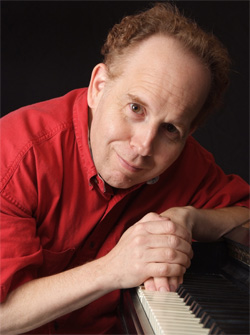by Robert Rollin
Last
Shapiro played Bach’s French Suite No 5 in G Major, BWV 816, a delightful Baroque dance collection, beautifully. The stately Allemande’s tempo was steady, yet flexible, enhancing the intricate mix of chromatic linear and harmonic treatment. The spritely Courante was nicely shaped, as Shapiro varied the repetitions with ornaments and dynamic changes. The movement’s second binary portion sparkled with many chromatic harmonies followed immediately by a closing Picardy third. The slow, soulful Sarabande was stunningly expressive, mixing stepwise and surprisingly angular melodic skips. The mood was that of a gorgeous Bach Cantata arioso, and Shapiro negotiated the tempo nuances tastefully. Shapiro continued to vary the repeats in both Gavotte and Bourée, and gave the whimsical and graceful Loure, a tasteful and imaginative performance. The closing fugal Gigue, replete with surging rhythms, was intense, yet graceful and expressive.
The Klavierstücke, op. 119, are among Brahms’s finest piano pieces. Shapiro played the B minor Intermezzo more slowly than most, but lingered appropriately on the exquisite descending third patterns that look ahead to French Impressionism, and enjoyed the sensuous dissonances as they unfurled. His simple, elegant performance did justice to Brahms’s ingenious writing.
The E minor Intermezzo’s agitated mood unfolded in a surprisingly rapid tempo that made a great contrast to the previous piece. The soft middle section, Andantino grazioso, in the parallel major mode, unfolded sweetly and tenderly, ultimately slowing before the intense agitated return. The pulsating Agitato theme is one of Brahms piano music’s great moments.
The C Major Intermezzo has an almost orchestral character. Brahms places the main melody in the middle voice, as the three- to four-voice harmony supports from above. Shapiro brought the line out clearly enough, without overdoing things, and played the piece with elegant elan.
The Rhapsodie in E-flat Major, yet another masterpiece, begins with a martial air, but continuously changes to arpeggiated sixteenth notes and to more gracefully flowing textures. Shapiro really understood the piece’s varied qualities, and made the final returning martial theme especially powerful.
The second half of the concert centered on Slavic music. Dvorak’s Piano Trio No. 4 in E Minor, op. 90, “Dumky,” enabled Shapiro to play with two talented student artists: violinist Jinjoo Cho and cellist Matthew Allen. Both student artists have already had distinguished careers, and their sensitive performance and excellent ensemble, helped make the Trio a special treat. The mercurial changes of happy to sad and back helped engender the piece’s frenetic character, and showed off the three musicians’ ensemble talents.
Shapiro also played Tchaikovsky’s Dumka, op. 59, expressively. The title refers to a Slavic ballad, poem, or meditation generally describing heroic deeds. The mood here was also changeable, though not as extensively so as in the Dvorak trio. Though the second half music was not in a league with the first, it, notwithstanding, created a fine contrast and a lively conclusion.
Published on ClevelandClassical.com February 5, 2013
Click here for a printable version of this article.



